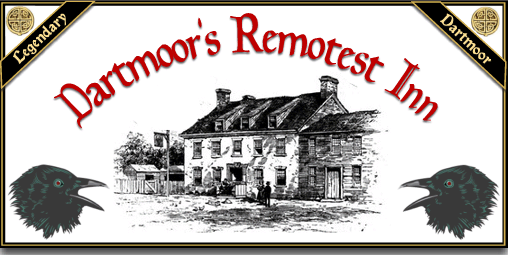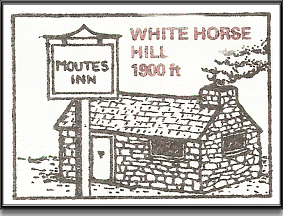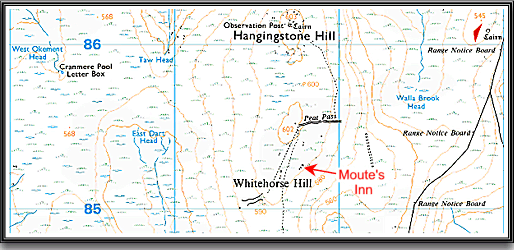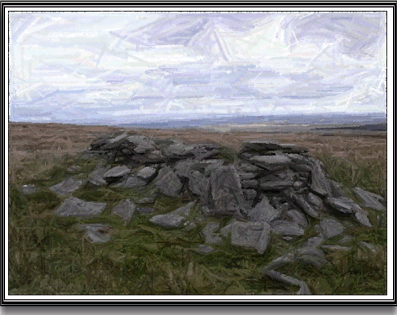
Do you enjoy visiting quiet secluded inns with ‘olde worlde’ charm, granite walls and splendid views? Do you savour sitting infront of a granite fire place with no jukebox, pool table, or gambling machines that blare out inane electronic tunes? What would you give to be able to sit and watch the moor ponies, sheep, and cattle over a relaxing tipple or a cup of coffee?
It was not the intention of this web site to promote moorland inns as I think recommendation is very much down to personal taste, what I may like hundreds probably would dislike and so it is something best left alone. But in this case I will make an exception. I know I will be lambasted for putting this place in the public domain because there are very few quiet inns left on Dartmoor and I am sure there are those who would like to keep what ones there are a secret. However, is it fair to deny visitors the opportunity of experiencing what must be a true Dartmoor atmosphere?
If you consult any of the Dartmoor guide books they will say that the Warren House Inn is the highest inn on Dartmoor at 427m. Sorry, this inn, (ie. the ‘Remotest’) stands at an altitude of 591m, so not only is it the remotest it is also the highest – you read it here! Despite its age there is very little in the way of folklore attached to the place. Many, many years ago the establishment was frequented by peat-cutters who worked in the nearby turf ties. It was said that on some nights there would be more peat on the customers than was burning on the fire. There was also tradition that the inn served the cheapest spirits on Dartmoor, although it can not be proven it is thought that the liquor was of a ‘contraband’ nature hence the price. Hemery, 1983, p.778 states that “a cache of contraband spirits was said to have been maintained here.” The very fact that such practices were indulged in is testament to the inn’s seclusion as not even the Excise Men were aware of its presence.
But what of the inn today? As has been alluded to, it is quiet, secluded and atmospheric. There are none of the modern day intrusive trappings such as juke boxes, pool tables etc. The building itself is almost as it was many years ago. There have been a few alterations but nothing that is not in keeping on that part of Dartmoor. The granite walls have not been plastered and the original floor is still in place along with the granite fireplace. The views from the inn are breathtaking, Hemery, p.779 clearly states that from what now could be called the ‘beer garden’, “the entire width of South Dartmoor is visible from Pupers, Snowdon and Ryder to Shiel top and the eastern highlands from Easdon Tor to Auswell Rocks…” Following the invention of the motor vehicle an nearby access road was constructed in 1963 to accommodate those using this part of the moor. I will warn you now the road is narrow and a bit bumpy in places. The inn is also a favourite venue for letterboxers and often of a Saturday lunchtime, over a sandwich or two, the topic of conversation at the inn will involve clues and stamps and what’s in and what’s out, so if you fancy a bit of ‘boxing chat’ here’s your place. You will also get the odd passing ‘twitcher’ calling at the inn, this part of the moor can be an excellent place for a spot of bird watching. This must have always been the case because once again Hemery, p. 779 remarks how one quiet December’s day he saw a passing Raven whose guttural croaks shattered the calm. Do they serve food I hear you ask, well in all honesty, nothing to write home about. The owners of the inn however have no objection to you bringing your own which seems to be an increasingly popular idea in Devon. The theory is that it cuts down on staffing overheads which in the case of this inn is minimal. What about the ale? I can guarantee that you will have ever tasted ale of the like, it is truly out of this world. Oh, and by the way the inn does not accept credit cards – cash only and if you work for the Inland Revenue, I never said that.
So what is the name of this inn … I can hardly bring myself to type the letters … it is called – Moute’s Inn. If ever you decide to pay a visit say hello to Pete ‘Passes’, he is never far away from the inn. He acquired his nickname because he never ‘passes’ the inn. Don’t forget to get a copy of the letterbox stamp either – always a nice memento.

Moute’s Inn letterbox stamp.
In fact Moute’s Inn is two things; Firstly it is some people’s idea of a bit of ‘fun’ and secondly it is the remains of a small shelter once used by moormen, in particular peat cutters. The reason the hut was called ‘Moute’s Inn was because at one time there was meant to be contraband liquor hidden there, possibly by a man called Moute. Why is it a bit of ‘fun’ because in some circles it is traditional to send visitors there when asked about the locality of a ‘nice pub’. The map below shows the locality of Moute’s Inn and as can be seen it is in the Fen and involves at least a three mile trek by foot or horseback. In theory with the help of a Landrover it would be possible to drive to within about 400ft of the ruin, this could be done by driving around the military road and up to Hangingstone Hill and then heading through the White Horse Peat Pass.

Although not marked on the OS map the little ruin is honestly called Moute’s Inn and you will find reference to it in any good Dartmoor book.

Sketch of ‘Moute’s Inn’
Bibliography.
Hemery, E. 1983 High Dartmoor, Hale, London.
 Legendary Dartmoor The many aspects past and present of Dartmoor
Legendary Dartmoor The many aspects past and present of Dartmoor
